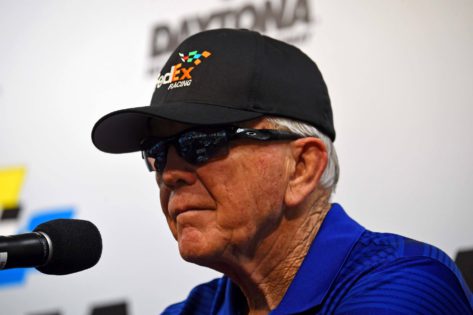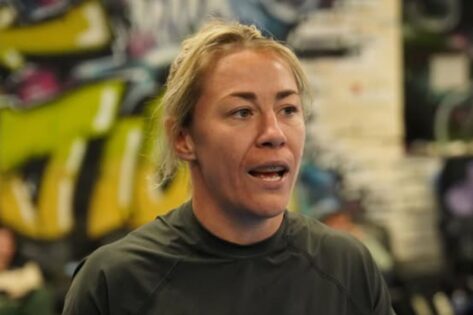The crowd at the track buzzed in restless anticipation, scanning the sky and stopwatch screens as another intense race unfolded under brutal summer heat. Midway through the run, the tension behind the pit wall began to sharpen, not because of lead changes or drafting duels, but something more subtle. Trackside scanners crackled with concern as spotters and broadcasters picked up on troubling signs emerging mid-pack, turning out to be something costly for Joe Gibbs Racing. A thin trail of smoke, a sudden wobble, a sharp radio call: something wasn’t right.
Jamie McMurray’s voice, urgent over the airwaves, stirred a ripple of alertness among veteran fans. They’d learned over time to hear more than just the laps; they could recognize the shifts, when excitement started to stretch toward unease. What happened in those moments became one of the most discussed flashpoints of the weekend, not due to a wreck in the conventional sense, but because of what did or didn’t happen in the seconds that mattered most.
Joe Gibbs Racing left paying the price
The incident at the center of the controversy involved Matt DiBenedetto during the NASCAR Xfinity Series race at Iowa Speedway. Early in the race, DiBenedetto made contact with another driver, Corey Day, which caused significant damage to his No. 99 Viking Motorsports Chevrolet. Specifically, his car’s nose was smashed. This collision also pushed oil from DiBenedetto’s car onto the racetrack. Despite evident signs of trouble, including smoke trailing from DiBenedetto’s car and reports of oil, NASCAR race control did not immediately throw a caution flag. This allowed the race to continue under green flag conditions for about a lap.
The failure to call a caution promptly led to dangerous track conditions since oil was spread on the surface. Shortly after, Brandon Jones spun out precisely in the section of the track where oil was reported, along with other drivers losing control in that area, confirming the hazard. The caution flag was only thrown after the incident escalated, resulting in a flurry of spins and accidents caused by the oil slick on the high-speed track.
Matt DiBenedetto got his nose smashed in midpack and had smoke trailing heavily from his car.
Jamie McMurray said there might be oil on the racetrack and was pleading for NASCAR to throw the yellow…and Brandon Jones spun out in that section of the track a lap later. pic.twitter.com/lVZNABaI9K
— Steven Taranto (@STaranto92) August 2, 2025
This incident is only the latest in a long line of close calls and post-race anger. Criticism of NASCAR’s judgment calls, especially regarding quick decisions for caution flags, spans years. Yet, recent accidents have shown the risks aren’t theoretical. In the Daytona 500, Ryan Preece’s frightening flip after a collision reignited broader questions about whether the sport takes every obvious danger seriously enough. After his crash at the Daytona 500, Preece told the Associated Press that, “I don’t want to be the example. When it [death] finally does get somebody, I don’t want it to be me”.
This sequence highlighted the delayed response from race control to clear a hazardous condition that was visibly impacting driver safety. The decision not to immediately call the caution despite multiple warnings and clear evidence of danger on the track drew heavy criticism and raised questions about NASCAR’s race management and safety protocols.
NASCAR has implemented structural changes in response to high-profile injuries, like adding new crumple zones and adjusting car aerodynamics. Still, the events that took out a Joe Gibbs Racing contender highlight the gap between technical fixes and real-time race management. As one racing columnist noted, driver warnings are often the best line of defense; when ignored, the stakes rise instantly. With Joe Gibbs Racing losing out after a preventable on-track incident, their fans and crew were left with only bitter hindsight and questions about who is truly listening when seconds count.
Fan firestorm: demanding accountability from race control
It didn’t take long for fans to make their anger known, flooding social media with a torrent of pointed criticism and disbelief. Comments ranged from scathing indictments, “Whoever is in charge in race control needs to be fired” to exasperated observations: “Should we be shocked? NASCAR has been horrible with calling cautions this season.” Those on X (formerly Twitter) and community forums voiced a sense of déjà vu, with one stating, “Bad call, NASCAR. Everybody saw it!”
The frustration extended beyond just Joe Gibbs’ faithful, as even neutral observers seemed stunned by yet another blown safety decision. “I am beginning to question whether race control knows anything about racing and racecars,” one comment read, echoing a sense of disenchantment felt by many. Others displayed a reluctant pragmatism: “How could we expect race control to be looking at the same shots we are to see there is oil. We clearly have to temper expectations while they wait to confirm what is what.” Yet, the dominant theme remained hard-edged: that the governing body’s hesitation or reluctance to act on clear track dangers is costing teams and drivers dearly.
This skepticism isn’t new, but the intensity and unity of the reaction to Joe Gibbs Racing’s case highlighted a tipping point, especially with recent discussions about safety and officiating lingering from major crashes earlier in the year. Some fans even speculated about deeper issues within NASCAR’s race management: “Whoever is running race control needs to be fined/fired.” The piling on was relentless, demonstrating just how exposed NASCAR is to immediate feedback and backlash whenever judgment falters in the spotlight.
In a sport built on razor-thin margins and split-second risks, the demand for accountability has never felt more urgent. For Joe Gibbs Racing supporters and neutral fans alike, this was a moment when every “what if” felt both hauntingly close and entirely avoidable.
The post NASCAR Under Fire for Ignoring Dangerous Track Warnings, Costs Joe Gibbs Big appeared first on EssentiallySports.



